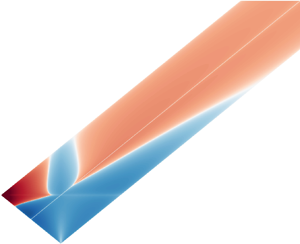Article contents
Locality of triad interaction and Kolmogorov constant in inertial wave turbulence
Published online by Cambridge University Press: 23 January 2023
Abstract

Using the theory of wave turbulence for rapidly rotating incompressible fluids derived by Galtier (Phys. Rev. E, vol. 68, 2003, 015301), we find the locality conditions that the solutions of the kinetic equation must satisfy. We show that the exact anisotropic Kolmogorov–Zakharov spectrum satisfies these conditions, which justifies the existence of this constant (positive) energy flux solution. Although a direct cascade is predicted in the transverse ( $\perp$) and parallel (
$\perp$) and parallel ( $\parallel$) directions to the rotation axis, we show numerically that in the latter case some triadic interactions can have a negative contribution to the energy flux, while in the former case all interactions contribute to a positive flux. Neglecting the parallel energy flux, we estimate the Kolmogorov constant at
$\parallel$) directions to the rotation axis, we show numerically that in the latter case some triadic interactions can have a negative contribution to the energy flux, while in the former case all interactions contribute to a positive flux. Neglecting the parallel energy flux, we estimate the Kolmogorov constant at  $C_K \simeq 0.749$. These results provide theoretical support for recent numerical and experimental studies.
$C_K \simeq 0.749$. These results provide theoretical support for recent numerical and experimental studies.
JFM classification
- Type
- JFM Rapids
- Information
- Copyright
- © The Author(s), 2023. Published by Cambridge University Press
References
REFERENCES
- 1
- Cited by



